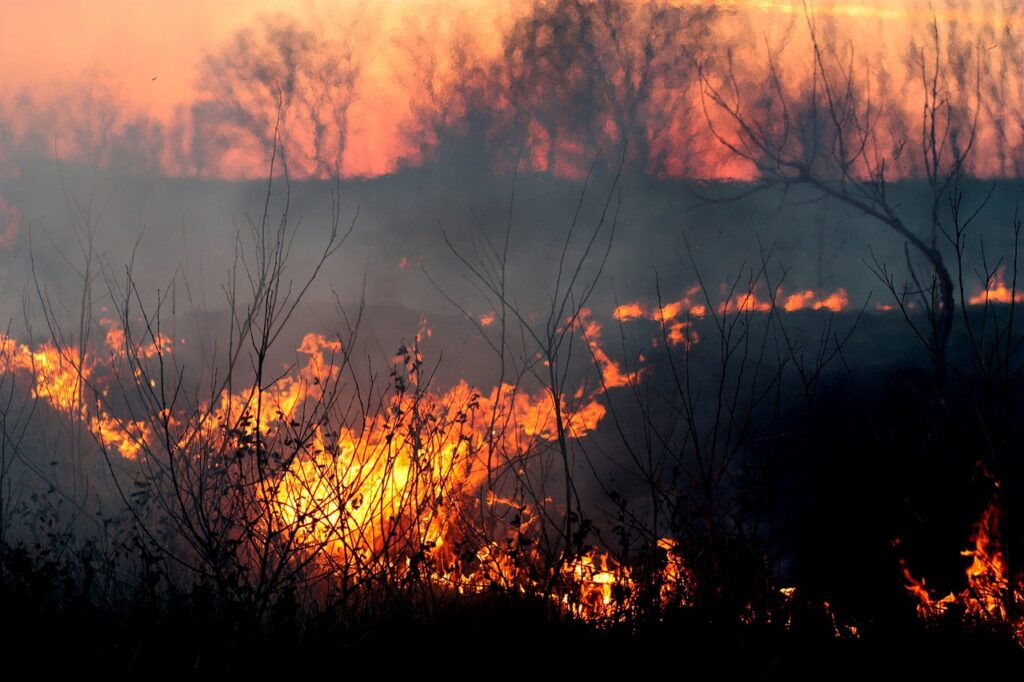Wildfire Risks: Growing threat in high-value areas
The risk of wildfires is on the rise, posing a serious threat to high-value real estate in regions such as Provence-Alpes-Côte d’Azur. Climate change has significantly contributed to the increased frequency and intensity of wildfires, making them more destructive than ever before. Factors such as prolonged droughts, higher temperatures, and changing weather patterns are creating ideal conditions for wildfires to ignite and spread rapidly.
While wildfires can occur in many parts of the world, certain regions are more susceptible due to their climate and vegetation. The Mediterranean region, including Provence-Alpes-Côte d’Azur, is particularly vulnerable. This area is characterized by hot, dry summers and dense vegetation, which can easily catch fire and fuel large-scale wildfires.

Impact on Property Values
Properties in wildfire-prone areas are experiencing a decline in value. Potential buyers are becoming increasingly wary of the risks associated with wildfires, leading to decreased demand and lower property prices. Homeowners in these areas are finding it challenging to sell their properties, and those who do often have to accept lower offers.
Rising Insurance Premiums and Buyer Behavior
Insurance premiums for properties in high-risk wildfire areas have soared. Insurers are factoring in the increased likelihood of fire damage, resulting in higher costs for homeowners. This rise in premiums further discourages potential buyers, who may look for safer, more affordable alternatives. The combination of lower property values and higher insurance costs is creating a challenging market for real estate in wildfire-prone regions.
Mitigation Efforts
To combat the growing threat of wildfires, developers are incorporating fire-resistant materials in the construction of new properties. Materials such as concrete, metal, and fire-resistant glass can significantly reduce the risk of fire damage. Additionally, these materials can help slow the spread of fires, providing valuable time for residents to evacuate and firefighters to respond.
Creating Defensible Spaces
Creating defensible spaces around properties is another crucial mitigation strategy. This involves clearing vegetation and other flammable materials from the area immediately surrounding a home. By reducing the amount of fuel available to a wildfire, defensible spaces can help protect properties and increase the chances of surviving a fire. Homeowners are encouraged to maintain these spaces regularly and follow local guidelines to ensure their effectiveness.
Provence-Alpes-Côte d’Azur: A High-Risk Region
Provence-Alpes-Côte d’Azur is a prime example of a high-risk wildfire region. The area has seen numerous destructive wildfires in recent years, causing extensive damage to homes, infrastructure, and natural habitats. The local government and communities have implemented various measures to mitigate the risks, but the challenges remain significant.
Recent wildfires in Provence-Alpes-Côte d’Azur have highlighted the importance of preparedness and rapid response. Effective communication between local authorities, emergency services, and residents is crucial in managing these events. Additionally, investing in fire-resistant infrastructure and community education can help reduce the overall impact of wildfires.
Technological advancements in fire prevention
Early Warning Systems
Technological advancements are playing a key role in wildfire prevention and management. Early warning systems, including satellite monitoring and weather prediction models, help detect potential fire risks before they escalate. These systems provide critical information to emergency services, allowing for timely evacuations and firefighting efforts.
Innovations in Firefighting Techniques
Innovations in firefighting techniques are also enhancing the ability to control and extinguish wildfires. Advanced equipment, such as drones and specialized aircraft, can monitor and attack fires more effectively. Additionally, new fire retardant chemicals and automated systems are being developed to protect homes and infrastructure from fire damage.
Stricter building codes and fire safety standards are essential for reducing wildfire risks. Regulations now require new constructions to incorporate fire-resistant materials and design features. Additionally, guidelines for maintaining defensible spaces and implementing fire safety measures are being enforced to protect properties and lives.
Conclusion
Wildfires pose a growing threat to high-value real estate, particularly in regions like Provence-Alpes-Côte d’Azur. The increasing frequency and intensity of these fires, driven by climate change, are having significant impacts on property values and insurance costs. However, through the use of fire-resistant materials, the creation of defensible spaces, and advancements in technology, there are effective strategies to mitigate these risks. Government policies, community involvement, and continued innovation are crucial in protecting properties and ensuring a safer future.
Take Action Now: For comprehensive data and tools to better understand and manage wildfire risks, visit Data4Risk. Leverage cutting-edge technology and analytics to safeguard your property and community from the growing threat of wildfires. Explore Data4Risk
